Building Scalable Cisco Networks
Take the Quiz BSCI Quiz Routing Protocols
Classfull Routing Protocols RIP and IGRP
Link state protocols support classfull addressing as well, but for exam purposes, consider them primarily used in a classless infrastructure. RIP and IGRP do not pass subnet information.
RIP
Route Metric HOPS and ticks. The max hop count is 16. Used in small diameter networks, does not scale well in a very large enterprise environment. Sends its entire routing table out to all its interfaces every 30 seconds.
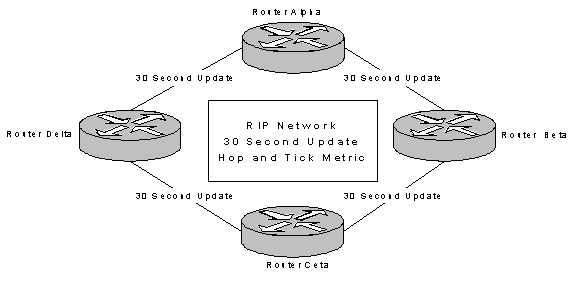
IGRP
Is a more robust than RIP. IGRP is a Cisco-proprietary classfull routing protocol. IGRP does not support VLSM or discontiguous subnets. IGRP will send its entire routing table every 90 seconds. Over slow links this can be a problem with the amount of bandwidth that would be consumed in updates.
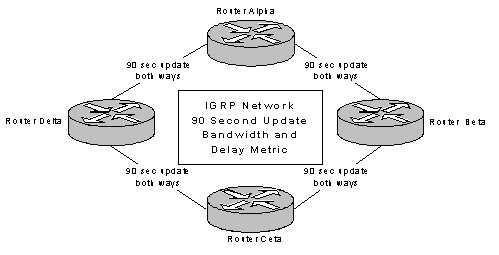
IGRP supports load balancing over paths with unequal bandwidth. The variance command is used to load balance IGRP.
Router igrp 90
Variance 3
The default variance is 1 for equal balancing. The variance multiplier can go 1-128.
IGRP uses a “keep alive” timer to determine if links are still up. Triggered updates cause the IGRP router to send a routing table update out if its interfaces. Periodic updates still get broadcasts sent to connected routers every 90 seconds.
Routing loops
Distance vector protocols use the following to prevent routing loops:
Hybrid Protocols
EIGRP
Considered a hybrid protocol. It combines the best features of both link state and distance vector. It can detect a link failure within one second. It converges rapidly and scales well into large networks. EIGRP sends routing updates to directly connected neighbors; only changes are sent rather than the entire routing table.
Bandwidth is the primary metric. That is why it is important to specify the bandwidth on an interface. EIRGP has a default for serial interfaces of 1.5Mbps. So you must set the correct bandwidth with the bandwidth command.
Advantages to EIGRP:
- VLSM Support
- Supports Discontiguous Subnets
- Multi-Protocol Support
- Automatic Route Summarization
- Keeps copy Neighbors Routes
- Load Balances up to 6 Paths
DUAL
Diffusing Update ALgorithm – The routing engine behind EIGRP. It allows for routers to update at the same time and allows for multi-protocol routing. It tracks route updates sent by neighbors and ensures against black holes.
EIGRP Discovery Process
EIRGP sends hello packets out of all of its interfaces to find its neighbors.


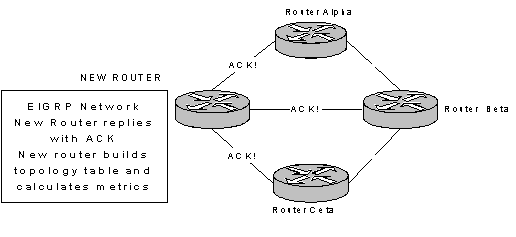
The new router then exchanges update packets with the adjacent routers. The adjacent routers then send ACKs to the new router. When this step is completed the new router will then choose its routes (successors).
Route Summarization for EIGRP
This is on by default, but only at the network or class boundaries. Manual configuration for route summarization is primarily done at the core or distribution layers. An example of the syntax for configuration is as follows:
ip summary-address eigrp 100 10.98.0.0 255.255.0.0
Important! By default, EIRGP does not support VLSM. You must use the no auto-summary command. Summaries are done at the interface level rather than at the router level. Use no auto-summary command to enable support of discontiguous subnets.
Example:
router eigrp 100
network 10.0.0.0
network 192.64.0.0
no auto summary
interface serial 1
ip address 10.98.98.24 255.255.255.0
bandwidth 128
ip summary-address eigrp 100 192.64.0.0 255.255.0.0
EIGRP Tables
EIGRP keeps three active tables in its database.
Topology Table – Is kept for each protocol. It is a table of all the route entries the router has learned. Syntax: show ip eigrp topology shows the number of successors, active or passive, and distance to destination.
Neighbor Table – EIGRP keeps a table for each adjacent router and one for each protocol. Syntax: show ip eigrp neighbors
Routing Table – Each protocol has its own routing table. EIGRP calculates the best route, or successor, from the topology table and puts the entry in the routing table. Syntax: show route eigrp
EIGRP Traffic
You can use the show ip eigrp traffic to view traffic statistics. This includes hello packets, updates, ACKs and replies.
EIGRP Configuration

Default routes
You can also configure the route to forward to a default network if a route is not found in the routers routing table. Use the following syntax:
router(config)#ip default-network 10.98.98.1
Static routes
Can be used between two AS’s or in a DDR situation. You define specific routes between the AS’s so you do not have to spend bandwidth on routing updates.
router(config)# ip route 10.98.8.0 255.255.255.0 172.16.32.0 e0 permanent
10.98.8.0 255.255.255.0 is the destination
172.16.32.0 is the next hop address.
Passive interface
You can configure EIGRP with a passive interface, which will not allow it send any routing updates including hello packets. Use the following syntax:
router(config-router)#passive-interface e0
Route filters
It is also possible to filter out inbound and outbound routing updates.
Outgoing Syntax:
router(config-router)# distribute-list 101 out e0 static
101= the access-list-number
out = filters for outbound
e0 = the interface
static = name of route process
Incoming Syntax:
router(config-router)# distribute-list 101 in e0
in = filters for inbound
e0 = the interface
Route Redistribution with EIGRP and IGRP
Routes can be redistributed within routing protocols. With EIGRP and IGRP this process is automatic if the AS systems numbers are the same. If the numbers are not the same then the redistribution will have to be done manually with the default- metric command:
router(config-router)# redistribute protocol X metric Y
router(config-router)#default-metric bandwidth delay reliability loading mtu
Route Redistribution with EIGRP and OSPF
Determine the core routing protocol.
Locate the router or ASBR where the route distribution needs to take be configured.
Make the decision of which is your short term or edge protocol.
Determine the route process where you want the route distributed.
Example: router(config)# router ospf X
X= the process id
Use the redistribute command to populate from the short term or edge protocol to the core routing protocol.
Example: router(config-router)# redistribute protocol X metric Y
X= the process id and Y = the metric value
router(config-router)# redistribute ospf 213 metric 110 subnets
router(config-router)# default-metric X
X= the metric value wanted
Define the seed metric to be used in the calculation of the value of the route before distribution.
For EIGRP
Router(config-router)# default-metric bandwidth delay reliability loading mtu
Administrative Distance
Advertised Distance
Advertised Distance is the distance a neighbor router says, or advertises, is the distance to a destination. This is key in electing a feasible successor or backup route. The lower the distance, the better. The lower the value the better the route is believable. These values can be changed with the distance command.
Administrative Distances
EIGRP and Dropped Links
When EIGRP discovers a down link the router does a lookup in its topology table for a successor. If a suitable one is found, it changes to the new route. The router then does a recalculation for the next successor. If one is not found, the router begins a new process.
The failed route or link is moved into active status and sends query packets to its adjacent neighbors. It multicasts out to every interface except the one it was learned from.
The router then waits for a response. If the adjacent router does not have a route to the destination, nor has a feasible successor, it sends a unicast packet back to the troubled querying router. If the neighbor router is using the troubled query router as a successor, it sends its own query packet to its neighbors. This query will propagate the entire AS.
If the troubled query router receives a successor, or feasible successor, the data is changed in the topology table and the router waits to receive more responses. The routing table is recalculated and the route is returned to passive state.
If no route updates for a successor or feasible successor are found, then the router deletes the entry from the topology database and routing table. If routers do not respond within 180 seconds their routes are also put into active state, and the query router begins to look for the additional routes it lost though the lost router.
EIGRP and NBMA
Take particular care when configuring EIGRP in a NBMA environment.
Three NBMA Scenarios:
- Pure point-to-point configuration – each PVC on subinterfaces
- Multi-point configuration – no subinterfaces
- Hybrid (mixed) multi-point and point-to-point
In these scenarios it is important that:
- The traffic bandwidth given to EIGRP on each VC must be the same in both directions;
- The total EIGRP traffic for the sum of all the VC’s must not exceed the line speed of the interface; and
- The EIGRP traffic allowed on one VC must not exceed the capacity of the VC.
Link State Protocols
OSPF (Open Shortest Path First)
Is a link state routing protocol that uses Dijkstra’s algorithm for route calculation.
OSFP has several advantages:
- VLSM Support
- Fast Convergence
- No Hop Count Limit
- Route Selection Based on Cost
- Low Bandwidth Usage
OSPF Commands (Single Area) Setup
router (config)#router ospf # (#=process ID)
- Enables ospf on the router
router (config-router)#network address wildcard-mask area # (#=area id)
- Address can be a subnet, network or the address of the interface
- Selects the networks that will be in the OSPF network
router (config-if)#interface loopback #(#=the loopback address)
- OSPF has been proven more reliable with a loopback number
- Loopback address can override the highest ip address for the router id
router (config-if)#ip ospf priority 0-255
router (config-if)#ip ospf cost # (#= the cost value 1-65535)
Cost values Ethernet=10, T1=128, 56k serial=1785
OSPF in a Single Area


Once the loading phase is completed and the router is ready to join the OSPF network, the router is in Full State.
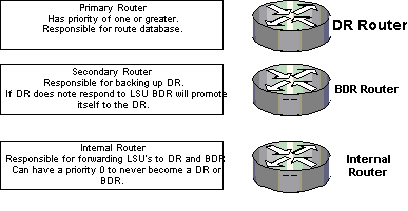
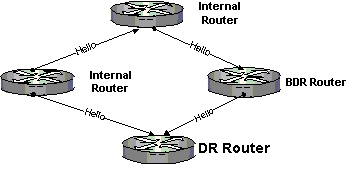
Routers exchange hello packets every 10 seconds to verify links are up. The Dead interval is 4X the hello interval.
SPF hold time - Is the time the router waits before doing a SPF route calculation. The default hold time is 10 seconds.
Neighbor relationships will vary with the connection types. Different OSPF configurations are required for each.
NBMA - Non-Broadcast Manual Configuration needed. Static lists for routes must be created.
Router must poll for the routing information since broadcasts are not allowed. Use the neighbor command to accomplish this.
neighbor ip-address X Y [X=priority #] [Y=poll-interval]
OSPF Multiple-Areas Configuration Commands Enable OSPF on the Router
router(config)# router ospf X (X=process id)
- Next step is to tell the router which networks are on the OSPF network
router(config-router)#network address wildcard-mask area (area id)
LSA1 – Router Links LSA – Sends information about the routers links.
LSA2 – Network Link LSA – Sent by the DR to all routers in the AS. A list of routers in the segment.
LSA3 – Summary Link LSA – Sent by ASBR’s list of networks available outside the area.
LSA4 – Summary Link LSA – Sent by ASBR’s list of networks available outside the area.
LSA5 – External Link LSA – Sent by ASBR’s list of external network routes.
OSPF recalculates a new table when a route goes down. So, if you have a link flapping you may want to increase the amount of time to wait. Use spf holdtime command. If not, it could overload CPU and cause performance issues.
Moustache

LSA’s are sent and an ACK is expected as a response. If an ACK is not received it will resend in 5 seconds. This can be changed with the command: ip ospf retransmit-interval 9 (changes retransmit time to 9 seconds)
Area Types – The area types determine what kind of LSA’s the area will receive.
Stub Area – Does not accept External LSA’s. LSA Type 5’s are rejected. Can except route summaries.
Totally Stubby Areas – Will not except any LSA’s with external or summaries.
Internal Routers – Exchange LSA’s 1 and LSA’s 2. They share the same routing database and all interfaces are within the same area.
Backbone Routers BBR – Exchange LSA’s 1 and LSA’s 2. Share at least on interface in the area 0.
Area Border Router ABR– Share an interface with another OSPF area. This router keeps a database for each area.
Autonomous System Border Router ASBR – Have at least one interface in a non-OSPF network. Its uses LSA 5’s to distribute this routing information into the OSPF network.
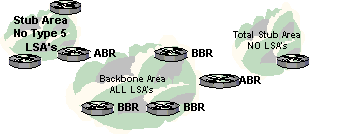
Route Table Updates
Routers take Type 1 and Type 2 LSA’s and make their own route calculations. These entries are used to modify the routing table.
The routers will also take Type 3 and Type 4 LSA’s and use them to calculate a route for areas in the internetwork. When a router has both an inter-area route and intra-area route are always kept. An easy way to remember this is, “Why go around the block to do next door?”
Only stub area routers do not expect type 5 LSA’s. All other routers perform path calculations to external AS’s.
Commands for Stub Area Configuration
router(config-router)#area area-id stub
- Configures Regular Stub area
router(config-router)#area area-id stub no-summary
- Configures A Total Stub Area
Commands for Route Summarization on OSPF
For ASBR’s:
router(config-router)#summary-address address mask
- Condenses inter-area routes into summary
For ABR’s:
router(config-router)#area area-id range address mask
- Condenses inter-area routes into summary
Commands for Troubleshooting OSPF
router#show ip route
- Gives the route information learned by the router.
router#show ip protocol
- Router information along with metrics and networks. Used to verify how OSPF is configured.
router#show ip ospf